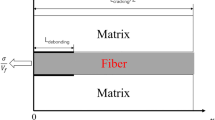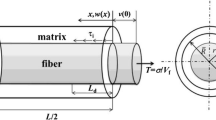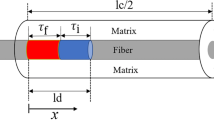Abstract
A new in situ strength model of carbon fibers was developed based on the distribution of defects to predict the stress-strain response and the strength of C/SiC composites. Different levels of defects in the fibers were considered in this model. The defects in the fibers were classified by their effects on the strength of the fiber. The strength of each defect and the probability that the defect appears were obtained from the tensile test of single fibers. The strength model of carbon fibers was combined with the shear-lag model to predict the stress-strain responses and the strengths of fiber bundles and C/SiC minicomposites. To verify the strength model, tensile tests were performed on fiber bundles and C/SiC minicomposites. The predicted and experimental results were in good agreement. Effects of the fiber length, the fiber number and the heat treatment on the final strengths of fiber bundles and C/SiC minicomposites were also discussed.













Similar content being viewed by others
References
Yu, G., Gao, X., Fang, G., Xue, J., Song, Y.: Strain field evolution of 2D needled C/SiC composites under tension. J. Eur. Ceram. Soc. 37, 531–537 (2017). https://doi.org/10.1016/j.jeurceramsoc.2016.09.030
Zhang, S., Gao, X., Chen, J., Dong, H., Song, Y.: Strength model of the matrix element in SiC/SiC composites. Mater. Design. 101, 66–71 (2016). https://doi.org/10.1016/j.matdes.2016.03.166
Fang, G., Gao, X., Yu, G., Zhang, S., Chen, J., Song, Y.: Effect of the stress level on the fatigue strengthening behavior of 2D needled C/SiC CMCs at room temperature. Mater. Design. 89, 432–438 (2016). https://doi.org/10.1016/j.matdes.2015.10.013
Genin, G.M., Hutchinson, J.W.: Failures at Attachment Holes in Brittle Matrix Laminates. J. Compos. Mater. 33, 1600–1618 (1999). https://doi.org/10.1177/002199839903301702
Mkaddem, A., El Mansori, M.: Finite element analysis when machining UGF-reinforced PMCs plates: Chip formation, crack propagation and induced-damage. Mater. Design. 30(8), 3295–3302 (2009). https://doi.org/10.1016/j.matdes.2008.12.009
Hashin, Z.: Failure criteria for unidirectional fiber composites. J. Appl. Mech. 47, 329–334 (1980). https://doi.org/10.1115/1.3153664
Kaiser, C., Weihs, H., Zuknik, K.H., Obst, A.: Failure criteria for FRP and CMC: theory, experiments and guidelines. European Conference on Spacecraft Structures, Materials & Mechanical Testing, Noordwijk (2005)
Baxevanis, T., Charalambakis, N.: A micromechanically based model for damage-enhanced creep-rupture in continuous fiber-reinforced ceramic matrix composites. Mech. Mater. 42, 570–580 (2010). https://doi.org/10.1016/j.mechmat.2010.02.004
Dutton, R.E., Pagano, N.J., Kim, R.Y., Parthasarathy, T.A.: Modeling the ultimate tensile strength of unidirectional glass-matrix composites. J. Am. Ceram. Soc. 83, 166–174 (2000). https://doi.org/10.1111/j.1151-2916.2000.tb01166.x
Liao, K., Reifsnider, K.L.: A tensile strength model for unidirectional fiber-reinforced brittle matrix composite. Int. J. Fract. 106, 95–115 (2000). https://doi.org/10.1023/A:1007645817
Zhang, R.L., Gao, B., Ma, Q.H., Zhang, J., Cui, H.Z., Liu, L.: Directly Grafting Graphene Oxide Onto Carbon Fiber and the Effect On the Mechanical Properties of Carbon Fiber Composites. Mater. Design. 93, 364–369 (2016). https://doi.org/10.1016/j.matdes.2016.01.003
Loidl, D., Paris, O., Rennhofer, H., Müller, M., Peterlik, H.: Skin-core structure and bimodal Weibull distribution of the strength of carbon fibers. Carbon. 45, 2801–2805 (2007). https://doi.org/10.1016/j.carbon.2007.09.011
Nemeth, N., Walker, A., Baker, E., Murthy, P., Bratton, R.: Large-scale Weibull analysis of H-451 nuclear-grade graphite rupture strength. Carbon. 58, 208–225 (2013). https://doi.org/10.1016/j.carbon.2013.02.054
Naik, D.L., Fronk, T.H.: Weibull distribution analysis of the tensile strength of the kenaf bast fiber. Fiber Polym. 17, 1696–1701 (2016). https://doi.org/10.1007/s12221-016-6176-6
Guo, M., Zhang, T.H., Chen, B.W., Cheng, L.: Tensile strength analysis of palm leaf sheath fiber with Weibull distribution. Compos. Part A-Appl. Sci. Manuf. 62, 45–51 (2014). https://doi.org/10.1016/j.compositesa.2014.03.018
Sakin, R., Ay, İ.: Statistical analysis of bending fatigue life data using Weibull distribution in glass-fiber reinforced polyester composites. Mater. Design. 29, 1170–1181 (2008). https://doi.org/10.1016/j.matdes.2007.05.005
Vautard, F., Dentzer, J., Nardin, M., Schultz, J., Defoort, B.: Influence of surface defects on the tensile strength of carbon fibers. Appl. Surf. Sci. 22, 185–193 (2014). https://doi.org/10.1016/j.apsusc.2014.10.066
Naslain, R., Lamon, J., Pailler, R., Bourrat, X., Guette, A., Langlais, F.: Micro/minicomposites: a useful approach to the design and development of non-oxide CMCs. Compos. Part A-Appl. Sci. Manuf. 30, 537–547 (1999). https://doi.org/10.1016/S1359-835X(98)00147-X
Maillet, E., Godin, N., R’Mili, M., Reynaud, P., Fantozzi, G., Lamon, J.: Damage monitoring and identification in SiC/SiC minicomposites using combined acousto-ultrasonics and acoustic emission. Compos. Part A-Appl. Sci. Manuf. 57, 8–15 (2014). https://doi.org/10.1016/j.compositesa.2013.10.010
Almansour, A., Maillet, E., Ramasamy, S., Morscher, G.N.: Effect of fiber content on single tow SiC minicomposite mechanical and damage properties using acoustic emission. J. Eur. Ceram. Soc. 35, 3389–3399 (2015). https://doi.org/10.1016/j.jeurceramsoc.2015.06.001
Gao, X., Zhang, S., Fang, G., Song, Y.: Distribution of slip regions on the fiber–matrix interface of ceramic matrix composites under arbitrary loading. J. Reinf. Plast. Compos. 34, 1713–1723 (2015). https://doi.org/10.1177/0731684415596596
Lissart, N., Lamon, J.: Damage and failure in ceramic matrix minicomposites: Experimental study and model. Acta Mater. 45, 1025–1044 (1997). https://doi.org/10.1016/S1359-6454(96)00224-8
Curtin, W.A., Ahn, B.K., Takeda, N.: Modeling brittle and tough stress–strain behavior in unidirectional ceramic matrix composites. Acta Mater. 46, 3409–3420 (1998). https://doi.org/10.1016/S1359-6454(98)00041-X
Cho, C., Holmes, J.W., Barber, J.R.: Estimation of interfacial shear in ceramic composites from frictional heating measurements. J. Am. Ceram. Soc. 74, 2802–2808 (1991). https://doi.org/10.1111/j.1151-2916.1991.tb06846.x
Zhang, S., Gao, X., Chen, J., Dong, H., Song, Y., Zhang, H.: Effects of micro-damage on the nonlinear constitutive behavior of SiC/SiC minicomposites. J. Ceram. Sci. Technol. 7, 341–348 (2016). https://doi.org/10.4416/JCST2016-00040
Acknowledgements
This work was supported by the National Key Research and Development Program of China [grant number 2017YFB0703200]; the National Natural Science Foundation of China [grant numbers 51575261, 51675266]; the Funding of Jiangsu Innovation Program for Graduate Education [grant number KYLX_0300]; and the Priority Academic Program Development of Jiangsu Higher Education Institutions.
Author information
Authors and Affiliations
Corresponding authors
Rights and permissions
About this article
Cite this article
Zhang, S., Gao, X. & Song, Y. In Situ Strength Model for Continuous Fibers and Multi-Scale Modeling the Fracture of C/SiC Composites. Appl Compos Mater 26, 357–370 (2019). https://doi.org/10.1007/s10443-018-9696-y
Received:
Accepted:
Published:
Issue Date:
DOI: https://doi.org/10.1007/s10443-018-9696-y




